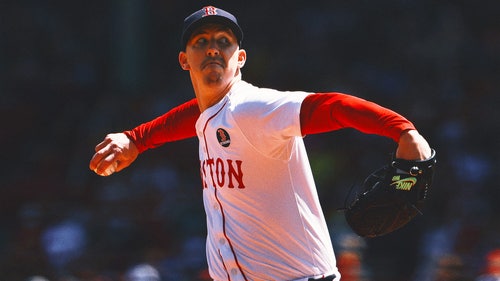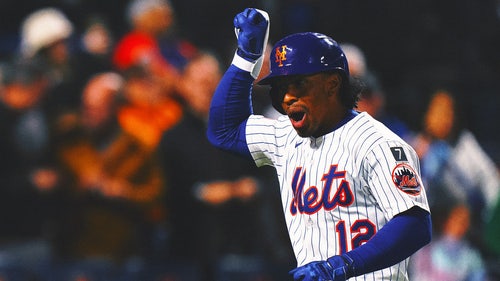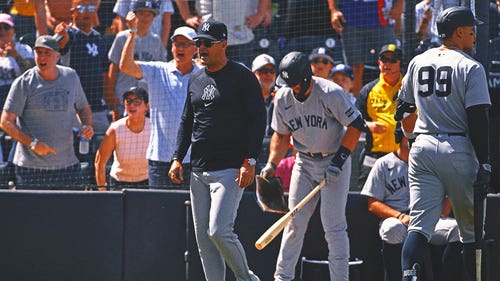
How the 2015 Tampa Bay Rays have overcome
By Jeff Sullivan
Last year’s Rays were, objectively, a disappointment. Forecast to do pretty well, the team ultimately lost more games than it won, finishing fourth in a surprising division. Beneath the surface numbers, though, there was something a little more positive — by BaseRuns, the Rays should’ve gone 83-79. Over the course of the year, the Rays underachieved what they arguably deserved, so the team was more competitive than it looked. But hey, 2014 was 2014. Those Rays traded David Price. They traded Ben Zobrist. They lost Joe Maddon. Early this year, the Rays lost Alex Cobb. They’ve been without Drew Smyly. They’ve been without Desmond Jennings. Last year, the Rays were borderline competitive, and they moved forward without the same talent.
And now they’re 41-32. They’re leading the East by a couple games, and the only bad team in that division has been the Red Sox. BaseRuns puts the Rays closer to 39-34, but that’s not a meaningful difference, the take-home message being, the Rays are fine. They’ve survived a massive talent loss, and if anything, now they’re playingbetter. Per usual, the Rays have had to overcome a number of obstacles in order to remain a relevant team. What, precisely, has taken place in Tampa Bay?
It’s easy enough to examine the bigger picture. Just looking at the last two seasons:
Pitching
2014: 95 FIP-
2015: 96
Hitting
2014: 99 wRC+
2015: 100
The pitching staff, as a whole, has been no less effective. The offense, as a whole, has been no less productive. Here you can see a big shift:
Defense
2014: +7 UZR
2015: +20 (so far)
2014: -34 DRS
2015: +12 (so far)
I know the numbers are different, and I know that frustrates some people, but the point isn’t the specifics. The point is that, by either measure, this year the Rays have fielded a better team defense than last year’s version. Unsurprisingly, that’s helped the pitchers, and when you have the same pitching staff and the same hitters and a better defense, that’s one way to have a better team.
But like I said, that’s the overall picture, and what makes this so remarkable is all the roster turnover between seasons. Roster turnover, and injuries. Consensus was that the Rays were going to be in a difficult place, and that was before injuries took their toll on the pitching staff. To this point, the team’s thrived, and now Matt Moore is almost back. Drew Smyly, too, might return before long from a torn labrum. We can run down a few of the keys. With a team like the Rays, it’s easy to get bogged down in the details, but it shouldn’t be hard to spot the biggest reasons why this team’s still successful.
Replacing Ben Zobrist with Logan Forsythe
By WAR, the best position player on last year’s Rays was Ben Zobrist, and it wasn’t particularly close. That was why Zobrist was such a hot commodity in the offseason, and that trade was a reason why people were down on this year’s roster. Team-building isn’t all about stars, but it tends to be a tricky thing to replace a near-6-win player. A season ago, Zobrist was a star who played five positions.
This year, Forsythe has played just three positions, but he’s been the second-best position player on the Rays by WAR. He’s been one of the team’s best hitters, performing even better than he did in what had appeared to be a breakout 2012. Forsythe was a Ray last year, and he was not a good one. There didn’t appear to be signs he was on the verge of another emergence. And maybe this is all a statistical bluff, but the power is up, and the strikeouts are down, and Forsythe has already achieved a carer-high in dingers. He’s hitting more balls in the air, and he isn’t going out of the zone. The Rays dealt a good player with versatility, and they’ve since developed another good player with versatility in his place. Luck? Coaching? Analytics? Couldn’t tell you. Whatever it is, it’s gotten them this far.
Playing More Kevin Kiermaier
Where last year, by WAR, Zobrist was the most valuable Rays position player, Kevin Kiermaier came in second despite playing as only a semi-regular. He finished with half as many plate appearances as Evan Longoria. Maybe that would’ve been easy to dismiss as a fluke, but now Kiermaier’s No. 1 on the team, and league-wide he’s rated as a top-10 outfielder. He’s on pace to bat 170 more times than he did in 2014. He’s on pace to play an extra 335 innings in the field. If there was anything fluky about Kiermaier’s 2014 performance, the fluke’s still going on. When a potential fluke repeats itself, the probability of flukiness is reduced.
Kiermaier’s a great example of an underrated player with a high floor. The Rays have understood from day one that Kiermaier is an exceptionally talented defensive outfielder, and when you have a guy that good in the field, he doesn’t need to hit that much to be a starter, and he doesn’t need to hit that much to be a tremendous asset. Kiermaier, sure enough, has rated as an outstanding defender to this point in his career. And he’s been a slightly above-average hitter, as he was in Double- and Triple-A.
He isn’t a household name, and he might never be. Zobrist isn’t a household name. The Rays don’t care about household names. They care that they have a center fielder who’s not meaningfully unlike, say, A.J. Pollock or Lorenzo Cain. Last October, Cain made his all-around value readily apparent. Kiermaier is like that, without the playoff highlight reel.
Building a different rotation front
This one isn’t easy to distill into a few words. The Rays no longer have Price. The Rays have had to play without Cobb. The Rays have mostly had to play without Smyly. Given the loss of talent and the injuries, it seems almost impossible that the Rays could still be pitching well, but, I’ll let this table speak for itself. A comparison of the top four Rays starters, from the last two years:
| Top 4 Starters | K% | BB% | FIP- | xFIP- | WAR/200 |
|---|---|---|---|---|---|
| 2014 | 24% | 7% | 89 | 90 | 3.5 |
| 2015 | 24% | 7% | 80 | 87 | 4.3 |
It’s like not a thing has been lost. And Cobb was a borderline ace. Price was a definiteace. Smyly was supposed to ease the pain of having lost Price. It’s been a group effort to overcome the adversity. Chris Archer has taken a leap forward, establishing himself as the new No. 1. Jake Odorizzi has gotten a bit better, thereby filling in for Cobb. Nate Karns has pitched a lot like last year’s version of Archer, and Erasmo Ramirez has been effective enough as the fourth. Slot by slot, the Rays starters have been different, but as a group, they’ve been no worse, and maybe a hair better. It helps that Archer now might be better than Price then.
For years, people have been saying good things about Jim Hickey. Stuff like this is why. As far as Hickey’s concerned, the Rays don’t have less talent; they just have different talent. He’s molded it into something strong, and reinforcements are going to start arriving. Hickey hasn’t yet been able to figure out Matt Moore, but the ability’s still in there. And the healthy version of Smyly, in Tampa Bay, has been excellent.
—–
There’s plenty more. In truth, this post could go on for a while. When the Rays lost Desmond Jennings to injury, they responded by platooning Brandon Guyer and David DeJesus. They’ve been very disciplined about the platoon — DeJesus leads all major-league lefties in rate of plate appearances with the platoon advantage, and Guyer is second among righties. The Rays have handled the platoon very carefully.
And without Jennings’ bat, the Rays turned to Joey Butler. Butler, as I write this, has the same wRC+ as Joc Pederson, Stephen Vogt, and Joey Votto. He’s not close to that good, but he owns a career .871 OPS in Triple-A, with an OBP a hair under .400. He was added for nothing in January.
A huge problem defensively last year was Yunel Escobar, and the Rays got rid of him. He was replaced by Asdrubal Cabrera, and, somewhat unexpectedly, he’s been a modest defensive plus. He certainly hasn’t been Escobar. Behind the plate, the previous Rays had a catcher who could frame but not hit. In Rene Rivera, they have a new and younger catcher who can frame but not hit. Rivera was picked up when the Rays flipped Wil Myers for Steven Souza. There was thought in the Rays’ front office that Souza was no worse an asset, despite Myers’ earlier hype, and what Souza has done is perform kind of like the healthy rookie Myers, from 2013. Power, strikeouts, and defense that doesn’t suck. Souza looks like a keeper.
All this has gone on, while the Rays switched leadership from Joe Maddon to Kevin Cash. Maybe this is the most important thing. Maybe this is the least important thing. It’s clear, given Maddon’s contract, he was highly valued by the Cubs. He was considered a bright and successful manager in Tampa Bay, a guy skilled at getting the most out of his clubhouse, but if the Rays were worried they’d take a step back, Cash has more than filled the void. It’s not proof that Maddon didn’t matter. It suggests just that Cash might not be worse, at least not with this team. This year’s Rays are maximizing what they have, and what they have is less, on paper, than they’ve had before. They lead their division, and injured players won’t be injured forever.
There was thought that the Tampa Bay Rays were in trouble. There was thought that their window was closing. The names all over the organization, for sure, are quite a bit different from just last year. I’m pretty sure that, for them, that’s the whole fun of it.
More from Fangraphs:





